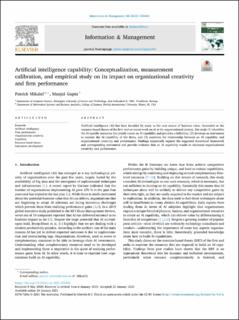| dc.contributor.author | Mikalef, Patrick | |
| dc.contributor.author | Gupta, Manjul | |
| dc.date.accessioned | 2022-02-23T10:22:59Z | |
| dc.date.available | 2022-02-23T10:22:59Z | |
| dc.date.created | 2021-04-08T15:59:00Z | |
| dc.date.issued | 2021 | |
| dc.identifier.citation | Information & Management. 2021, 58 (3), 1-20. | en_US |
| dc.identifier.issn | 0378-7206 | |
| dc.identifier.uri | https://hdl.handle.net/11250/2980958 | |
| dc.description.abstract | Artificial intelligence (AI) has been heralded by many as the next source of business value. Grounded on the resource-based theory of the firm and on recent work on AI at the organizational context, this study (1) identifies the AI-specific resources that jointly create an AI capability and provides a definition, (2) develops an instrument to capture the AI capability of the firms, and (3) examines the relationship between an AI capability and organizational creativity and performance. Findings empirically support the suggested theoretical framework and corresponding instrument and provide evidence that an AI capability results in increased organizational creativity and performance. | en_US |
| dc.language.iso | eng | en_US |
| dc.publisher | Elsevier Science | en_US |
| dc.rights | Navngivelse 4.0 Internasjonal | * |
| dc.rights.uri | http://creativecommons.org/licenses/by/4.0/deed.no | * |
| dc.title | Artificial intelligence capability: Conceptualization, measurement calibration, and empirical study on its impact on organizational creativity and firm performance | en_US |
| dc.type | Peer reviewed | en_US |
| dc.type | Journal article | en_US |
| dc.description.version | publishedVersion | en_US |
| dc.source.pagenumber | 1-20 | en_US |
| dc.source.volume | 58 | en_US |
| dc.source.journal | Information & Management | en_US |
| dc.source.issue | 3 | en_US |
| dc.identifier.doi | 10.1016/j.im.2021.103434 | |
| dc.identifier.cristin | 1903051 | |
| cristin.ispublished | true | |
| cristin.fulltext | original | |
| cristin.qualitycode | 1 | |

